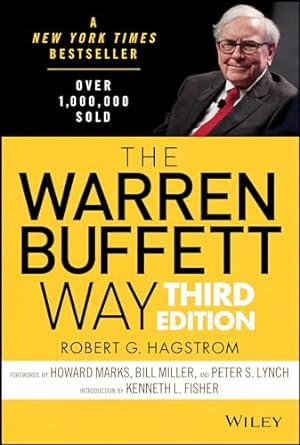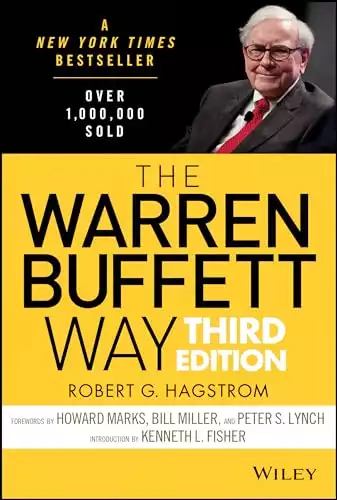Overview : The Warren Buffett Way
-
Book Title: The Warren Buffett Way
-
Author: Robert G. Hagstrom
-
Publication Date: October 1949
-
Rating: 4.5
-
price: $22.40
-
Pages: 320
About the Author
The Warren Buffett Way is authored by Robert G. Hagstrom, an investment expert known for simplifying complex financial strategies. The book explores the principles and strategies that Warren Buffett uses to identify value and achieve long-term investment success.
Introduction to The Warren Buffett Way By Robert G. Hagstrom
In the vast ocean of investment literature, The Warren Buffett Way by Robert G. Hagstrom stands as a lighthouse, illuminating the path to financial wisdom. This book offers invaluable insights into the principles and strategies of the legendary investor Warren Buffett. In The Warren Buffett Way review, we dive deep into how Hagstrom simplifies complex financial concepts, making them accessible for investors at all levels. From identifying value to achieving long-term success, this book serves as a blueprint for navigating the ever-changing world of finance with Buffett's proven methodologies.
The Warren Buffett Way Book Summary
Hagstrom's work is more than a mere biography; it's a deep dive into the mind of Warren Buffett, the Oracle of Omaha. The book meticulously unpacks Buffett's investment philosophy, which goes beyond mere number-crunching to encompass a holistic understanding of business fundamentals. Key aspects covered include:
- The influence of Benjamin Graham on Buffett's early career
- The evolution of Buffett's investment strategy
- The concept of intrinsic value and its calculation
- The importance of economic moats in long-term investing
- Buffett's approach to market volatility and risk management
Analysis of Themes
Value Investing in the Modern Era
Hagstrom brilliantly illustrates how Buffett adapted Graham's value investing principles to the contemporary market. This evolution demonstrates the timelessness of Buffett's approach, even as it incorporates new elements like qualitative analysis of management and long-term growth prospects.
The Power of Patience and Discipline
In an age of high-frequency trading and market volatility, Hagstrom emphasizes Buffett's unwavering commitment to long-term investing. This perspective serves as a counterpoint to the often frenzied nature of today's financial markets, highlighting the enduring value of patience in wealth creation.
Psychological Fortitude in Investing
The book delves into the psychological aspects of investing, an often-overlooked element in financial literature. Hagstrom portrays Buffett's emotional stability as a key factor in his success, offering readers insights into developing a resilient mindset for navigating market ups and downs.
Writing Style
Hagstrom's writing is clear, concise, and accessible, making complex financial concepts digestible for readers of various backgrounds. He skillfully weaves anecdotes and case studies throughout the narrative, bringing Buffett's strategies to life through real-world examples.
Strengths and Weaknesses of The Warren Buffett Way
Strengths:
- In-depth analysis of Buffett's investment philosophy
- Practical examples and case studies
- Clear explanations of complex financial concepts
- Balanced view, including discussions of Buffett's missteps
Weaknesses:
- May not fully address recent market trends like cryptocurrencies
- Could benefit from more comparative analysis with other investment strategies
The Warren Buffett Way Related Books
While "The Intelligent Investor" by Benjamin Graham provides the foundational principles of value investing, "The Warren Buffett Way" offers a more modern and practical application of these concepts. Compared to "One Up On Wall Street" by Peter Lynch, Hagstrom's book focuses more on long-term, fundamental analysis rather than Lynch's emphasis on growth stocks and personal knowledge in investing.
Key Quotes
"In the short run, the market is a voting machine, but in the long run, it is a weighing machine." - Benjamin Graham, as quoted by Warren Buffett "It's far better to buy a wonderful company at a fair price than a fair company at a wonderful price." - Warren Buffett
Highlights from The Warren Buffett Way by Robert G. Hagstrom
Focus on Value Investing: Buffett emphasizes buying businesses at prices below their intrinsic value.
Understanding the Business: Invest in companies you thoroughly understand, with a clear business model and predictable earnings.
Management Quality: Prioritize companies with competent, shareholder-focused management teams.
Long-Term Perspective: Hold investments for the long term, benefiting from compound growth and avoiding short-term market noise.
Economic Moat: Look for businesses with competitive advantages that protect them from competitors.
Discipline and Patience: Avoid emotional decision-making; wait for the right opportunities.
Avoid Market Speculation: Focus on fundamentals, not market trends or predictions.
Conclusion
"The Warren Buffett Way" is more than just a book; it's a masterclass in intelligent investing. Hagstrom's work provides readers with the tools to approach the market with confidence, discipline, and a long-term perspective. In an era of rapid technological change and market volatility, the timeless wisdom presented in this book serves as a stabilizing force for investors at all levels. Whether you're a seasoned financial professional or a novice investor, this book offers invaluable insights into building a robust investment strategy. By embracing Buffett's principles of patience, thorough research, and value-oriented thinking, readers can navigate the complex world of finance with greater clarity and purpose.
Ready to transform your investment approach?
Click here to purchase "The Warren Buffett Way" on Amazon and start your journey towards financial wisdom today. Your portfolio will thank you! In conclusion, this article has provided an overview of the topic at hand.





